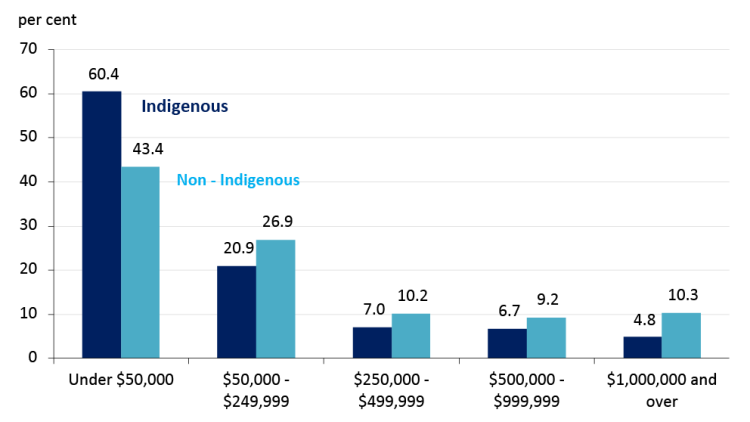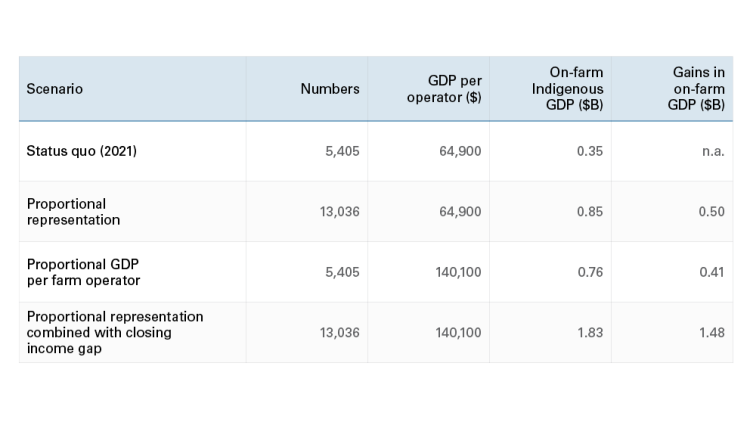Indigenous agriculture opportunities could boost GDP by $1.5 billion

Indigenous people have a long history in agriculture, yet Indigenous participation in agriculture continues to be under-represented. Increasing participation of Indigenous people into agriculture and bridging the gap in farm income between Indigenous and non-Indigenous farm operations represent a $1.5 billion boost in primary agriculture GDP. Renewed efforts towards reducing barriers in access to capital, equipment, and skilled labour, improved agricultural knowledge and farming methods are paths towards boosting Indigenous agriculture production, promoting Indigenous health, increasing food security, and strengthening Canada’s economic well-being and resiliency.
Indigenous population remains under-represented in agriculture
Data from Statistics Canada suggests that the Indigenous population continues to face large and persistent economic disparities relative to non-Indigenous people in Canada.
According to the 2021 census, more than 1.8 million people identified as Indigenous, representing 5% of Canada’s total population. Relative to the agriculture sector, there were 5,405 Indigenous farm operators out of 262,045 farm operators (2.1%) in Canada. Although this represents a 5% increase in participation from the previous census, there is still a large possibility to expand participation. Indigenous farm operators live in all provinces and territories, with the four western provinces accounting for over 70% of Indigenous farm operators. Saskatchewan has the highest number of Indigenous operators at 1,165 (21.6%) followed by Alberta with 1,130 (20.9%). Indigenous farming operations are more predominant in oilseeds and grains, vegetables, fruits, and other crops including greenhouse production followed by beef cattle ranching and farming.
Bringing equitable representation of the Indigenous population into agriculture would imply increasing the number of Indigenous farm operators to a similar level as their contribution to the total Canadian population, welcoming an additional 7,631 Indigenous farm operators in the ag economy, a 140% increase.
Closing the gap between Indigenous and non-Indigenous farm revenue
The impact of historical injustices on Indigenous peoples cannot be underestimated. Ongoing generational effects from the Indian Act, residential school experiences, the 60’s scoop, and other factors contribute to significant and enduring economic differences between Indigenous and non-Indigenous Canadian populations. Lack of access to capital, lower rates of participation of Indigenous people in the labour force, access and level of education attained, and higher unemployment are all major contributing factors that continue to hinder Indigenous economic progress overall, and in the ag economy.
According to Statistics Canada, the median farm operating revenue for Indigenous farm operators in 2020 was $25,960, compared to non-Indigenous operators who earned $73,440. This is a revenue disparity of $47,480, or nearly 65%. The revenue disparity declined slightly between 2015 and 2020, being at $49,900 (adjusted for inflation) in 2015. Revenue inequality has therefore improved slightly over the last five years.
These differences are largely due to under-representation of Indigenous farm operators in higher farm revenue brackets. Indigenous operators are highly represented in the lower threshold revenue classes (Figure 1), with 60% of Indigenous operators earning less than $50,000 annually, compared to 43% of non-Indigenous operators. This goes to suggest that although some Indigenous operators own major farming operations, most Indigenous operations are small-scale oriented.
Figure 1: Revenue class of Indigenous and non-Indigenous farm operators

Sources: Statistics Canada and FCC calculations
Closing the revenue gap between Indigenous and non-Indigenous farm operations can be converted to a contribution to the economy measured in terms of GDP. GDP related to Indigenous primary farming operations was estimated to be $351 million, or 1.0% of Canada’s primary agriculture GDP in 2021. Conversely, the GDP contribution of non-Indigenous farm operations was $35.9 billion. This estimated primary agriculture GDP per farm operator was $64,900 for Indigenous and $140,100 for non-indigenous, for a GDP per farm disparity of $75,200.
Potential of growing Indigenous representation and revenue
An equitable representation of Indigenous agriculture implies an increase in the number of operators as well as in revenues generated per farm.
Table 1 summarizes the impact on Indigenous and Canada’s agriculture GDP if we increase Indigenous participation in the sector and revenue generated per farm. Achieving these goals would increase Canadian primary agriculture GDP by $1.5 billion.
Table 1: Indigenous agriculture potential GDP growth

Sources: Statistics Canada and FCC calculation
An opportunity for the overall economy
Working towards achieving economic parity for Indigenous people in Canada presents an opportunity to lift the economic resilience of Indigenous populations as well as promoting food security. Increasing Indigenous participation in agriculture is a $1.5 billion opportunity which would more than quadruple Indigenous agriculture GDP and provide an estimated 4.0 % boost in Canada’s primary agriculture GDP. Government programs such as the Indigenous agriculture and food systems initiative and funding programs for Indigenous and northern communities and organizations are laudable, and could be complemented with an innovation plan and collaboration between all stakeholders to address the barriers to increasing Indigenous participation in primary agriculture and agri-food business.

Isaac Kwarteng
Senior Economist
Isaac Kwarteng is a Senior Economist at FCC, focusing on long-term economic research and forecasting to support strategy and risk. He also supports the CEO’s office with information and data requests.
Isaac joined FCC in 2023 from the Government of Saskatchewan, where he worked for a decade in economic, research and statistical roles.
Isaac received his master’s degree in economics from the University of East Anglia in the UK. He also has a master’s degree in statistics from the University of Regina and is currently enrolled in the Ph.D. program.
